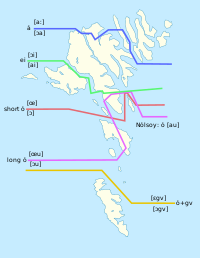Vowels

| Front | Central | Back | ||||||
|---|---|---|---|---|---|---|---|---|
| unrounded | rounded | |||||||
| short | long | short | long | short | long | short | long | |
| Close | ɪ | iː | ʏ | (yː) | ʊ | uː | ||
| Mid | ɛ | eː | œ | øː | ɔ | oː | ||
| Open | a | (aː) | ||||||
- /yː/ and /aː/ appear only in loanwords.[1]
- The long mid vowels /eː, øː, oː/ tend to be diphthongized to [eɛː ~ eəː, øœː ~ øəː, oɔː ~ oəː].[1]
- According to the mean formant values of the native vowels (so excluding /yː/ and /aː/) in Peterson (2000), cited in Árnason (2011:76):
- /ɪ, ʏ, ʊ/ are more open than the corresponding tense vowels, with /ɪ/ being the most open of the three ([ɪ̞]) and having the same F1 value as the back /oː/. The F2 value of /ʏ/ is closer to that of /ɪ/, which means that it is a front vowel.
- /øː/ and especially /eː/ are more open than the phonetically close-mid /oː/ ([oː], often diphthongized to [oɔː ~ oəː]). Both /øː/ and /eː/ are more open than the corresponding short vowels; in addition, /øː/ is more central than any of the mid front vowels, including /œ/, whereas /eː/ is the most front of the mid vowels. This suggests that they are best transcribed [ɞː] and [ɛː] in narrow transcription, at least in the case of the monophthongal variants (Árnason reports opening diphthongs [øœː] and [eɛː] as one common type of realization of /øː/ and /eː/. Those diphthongs have considerably more close starting points).
- The F1 value of /a/ is just slightly higher than that of /eː/, suggesting that it is a near-open vowel. In addition, its F2 value is closer to /ɔ/ than /œ/, which suggests that it is a near-open near-back vowel [ɑ̽].
- /œ/ is considerably more close than /a/ but not as close as /oː/. It is more front than /øː/, which suggests that it is a mid front vowel [œ̝].
- /ɔ/ has the same F1 value as /œ/, which suggests that it is also true-mid [ɔ̝]. The remaining short mid /ɛ/ is more open than those two, suggesting [ɛ] as the best narrow transcription.
As with other Germanic languages, Faroese has a large number of vowel phonemes; by one analysis, long and short vowels may be considered separate phonemes, with 26 in total. Vowel distribution is similar to other North Germanic languages in that short vowels appear in closed syllables (those ending in consonant clusters or long consonants) and long vowels appearing in open syllables.
| Monophthongs | ||||||
|---|---|---|---|---|---|---|
| Long vowel | Short vowel | |||||
| /i/ | linur | [ˈliːnʊɹ] | 'soft' | lint | [lɪn̥t] | 'soft (N.)' |
| /e/ | frekur | [ˈfɹeː(ʰ)kʊɹ ~ ˈfɹeεːkʊɹ] | 'greedy' | frekt | [fɹɛʰkt] | 'greedy (N.)' |
| /y/ | mytisk | [ˈmyːtɪsk] | 'mythological' | mystisk | [ˈmʏstɪsk] | 'mysterious' |
| /ø/ | høgur | [ˈhøːʋʊɹ ~ ˈhøœːʋʊɹ] | 'high (M.)' | høgt | [hœkt] | 'high (N.)' |
| /u/ | gulur | [ˈkuːlʊɹ] | 'yellow' | gult | [kʊl̥t] | 'yellow (N.)' |
| /o/ | tola | [ˈtʰoːla ~ ˈtʰoɔːla] | 'to endure' | toldi | [ˈtʰɔltɪ] | 'endured' |
| /a/ | Kanada | [ˈkʰaːnata] | 'Canada' | land | [lant] | 'land' |
| Diphthongs | ||||||
| Long vowel | Short vowel | |||||
| /ʊi/ | hvítur | [ˈkfʊiːtʊɹ] | 'white (M.)' | hvítt | [kfʊiʰtː] | 'white (N.)' |
| /ɛi/ | deyður | [ˈteiːjʊɹ] | 'dead (M.)' | deytt | [tɛʰtː] | 'dead (N.)' |
| /ai/ | feitur | [ˈfaiːtʊɹ] | 'fat (M.)' | feitt | [faiʰtː ~ fɔiʰtː] | 'fat (N.)' |
| /ɔi/ | gloyma | [ˈklɔiːma] | 'to forget' | gloymdi | [ˈklɔimtɪ] | 'forgot' |
| /ɛa/ | spakur | [ˈspɛaː(ʰ)kʊɹ] | 'calm (M.)' | spakt | [spakt] | 'calm (N.)' |
| /ɔa/ | vátur | [ˈvɔaːtʊɹ] | 'wet (M.)' | vátt | [vɔʰtː] | 'wet (N.)' |
| /ʉu/ | fúlur | [ˈfʉuːlʊɹ] | 'foul (M.)' | fúlt | [fʏl̥t] | 'foul (N.)' |
| /ɔu/ | tómur | [ˈtʰɔuːmʊɹ ~ ˈtʰœuːmʊɹ] | 'empty (M.)' | tómt | [tʰœm̥t ~ tʰɔm̥t] | 'empty (N.)' |
Faroese avoids having a hiatus between two vowels by inserting a glide between them.
There is considerable variation among dialects in the pronunciation of vowels.

The only unstressed vowels in Faroese are short [a, ɪ, ʊ]; these appear in inflectional endings: áðrenn (e.g. [ˈɔaːɹɪnː] 'before'). Very typical are endings like -ur, -ir, -ar. The dative is often indicated by [ʊn].
- [a] – bátar [ˈpɔaːtaɹ] ('boats'), kallar [ˈkʰatlaɹ] ('[you] call')
- [ɪ] – gestir [ˈtʃɛstɪɹ] ('guests'), dugir [ˈtuːɪɹ] ('[you] can')
- [ʊ] – bátur [ˈpɔaːtʊɹ] ('boat'), gentur [tʃɛn̥tʊɹ] ('girls'), rennur [ˈɹɛnːʊɹ] ('[you] run').
In some dialects, unstressed short /ʊ/ is realized as [ø] or is reduced further to [ə]. /ɪ/ goes under a similar reduction pattern as it varies between [ɪ ~ ɛ ~ ə] so unstressed /ʊ/ and /ɪ/ can rhyme. This can cause spelling mistakes related to these two vowels. The following table displays the different realizations in different dialects.
| Word | Borðoy Kunoy Tórshavn |
Viðoy Svínoy Fugloy |
Suðuroy | Elsewhere (standard) |
|---|---|---|---|---|
| gulur ('yellow') | [ˈkuːləɹ] | [ˈkuːləɹ] | [ˈkuːløɹ] | [ˈkuːlʊɹ] |
| gulir ('yellow' PL) | [ˈkuːləɹ] | [ˈkuːləɹ] | [ˈkuːløɹ] | [ˈkuːlɪɹ] |
| bygdin ('town') | [ˈpɪktɪn] | [ˈpɪktən] | [ˈpɪktøn] | [ˈpɪktɪn] |
| bygdum ('towns' DAT.PL) | [ˈpɪktʊn] | [ˈpɪktən] | [ˈpɪktøn] | [ˈpɪktʊn] |